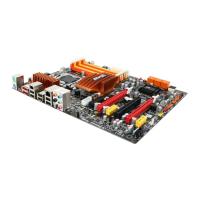
Do you have a question about the ECS X58B-A2 and is the answer not in the manual?
| Form Factor | ATX |
|---|---|
| CPU Socket | LGA 1366 |
| Memory Type | DDR3 |
| Memory Slots | 6 |
| Maximum Memory Supported | 24 GB |
| PCI Express 2.0 x16 | 2 |
| PCI Express x1 | 1 |
| PCI Express x4 | 1 |
| PCI Slots | 2 |
| SATA 3Gb/s | 6 |
| SATA RAID | 0, 1, 5, 10 |
| Audio Chipset | Realtek ALC888 |
| Max LAN Speed | 10/100/1000 Mbps |
| Chipset | Intel X58 |
| Memory Standard | DDR3 1600/1333/1066 |
| USB 2.0 | 12 |
| Audio Channels | 8 |
| LAN Chipset | Realtek RTL8111 |
| LAN | 1 |
Legal terms for content reproduction and use.
Information on product limitations and brand names.
Details on FCC standards and guidelines.
Statement regarding Canadian regulatory requirements.
Summary of the manual's structure and chapter topics.
General introduction to the motherboard's capabilities and target market.
Detailed description of processor, chipset, memory, audio, and LAN.
Information on expansion slots, FireWire, I/O ports, and BIOS firmware.
Critical safety guidelines to follow during motherboard installation.
How to set and verify motherboard jumpers for correct operation.
Step-by-step guide for installing the CPU and memory modules.
Guidelines for installing add-on cards and connecting I/O devices.
Instructions for connecting case fans, switches, and power supply.
Introduction to the BIOS interface, navigation, and basic setup.
Procedure for resetting BIOS settings to default values.
Displays basic system information and device detection.
Settings for Serial ATA drives and controllers.
Advanced system configuration settings for performance.
Settings for onboard devices like audio, LAN, and USB.
Options for controlling system power states and wake-up events.
Configuration for PCI bus devices and system plug-and-play.
Monitoring system temperatures, voltages, and fan speeds.
BIOS settings related to CPU clock speed and bus configuration.
Options for loading system defaults and setting supervisor passwords.
Setting user passwords and procedures for saving or exiting BIOS.
Description of drivers and utilities on the CD.
Explanation of installation tabs and how to initiate the setup process.
Guide for automated software installation.
Specific guidance for installing drivers on Windows Vista.
Steps for manual driver installation and information on utility software.
Prerequisites and steps for installing multiple graphics cards for CrossFire™.
How to enable and manage CrossFire™ settings using the control center.
Items needed and how to enter the RAID utility.
Instructions to enter the RAID management interface.
Procedure for creating RAID 0 or RAID 1 volumes.
Steps to remove existing RAID configurations.
How to convert RAID disks back to Non-RAID.
Procedure to safely exit the RAID management interface.